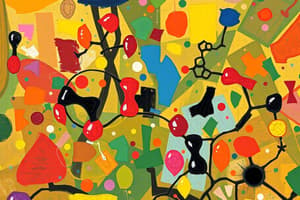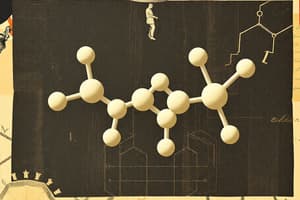Podcast
Questions and Answers
What is the term used to describe the cyclic form of glucose with a six-membered ring?
What is the term used to describe the cyclic form of glucose with a six-membered ring?
- Furanose
- Pyranose (correct)
- Hemiacetal
- Hemiketal
Which of the following is NOT one of the three forms of D-glucose?
Which of the following is NOT one of the three forms of D-glucose?
- β-D-glucopyranose
- Open-chain form
- D-fructofuranose (correct)
- α-D-glucopyranose
What type of reaction is involved in the formation of a hemiacetal?
What type of reaction is involved in the formation of a hemiacetal?
- Addition reaction (correct)
- Elimination reaction
- Substitution reaction
- Oxidation reaction
What specific carbon atom in D-glucose is involved in the formation of the cyclic structure?
What specific carbon atom in D-glucose is involved in the formation of the cyclic structure?
What is the difference between α-D-glucopyranose and β-D-glucopyranose?
What is the difference between α-D-glucopyranose and β-D-glucopyranose?
What is the name of the projection used to represent the cyclic forms of sugars?
What is the name of the projection used to represent the cyclic forms of sugars?
Which of the following is a characteristic of the anomeric carbon in a cyclic sugar?
Which of the following is a characteristic of the anomeric carbon in a cyclic sugar?
What is the major difference between the structures of glycogen and cellulose?
What is the major difference between the structures of glycogen and cellulose?
What is the name of the cyclic form of fructose?
What is the name of the cyclic form of fructose?
What is the main difference between Hemiacetal formation and Hemiketal formation?
What is the main difference between Hemiacetal formation and Hemiketal formation?
What distinguishes a D isomer from an L isomer in a monosaccharide?
What distinguishes a D isomer from an L isomer in a monosaccharide?
Which of the following statements about epimers is correct?
Which of the following statements about epimers is correct?
What is an example of enantiomers in sugars?
What is an example of enantiomers in sugars?
Which set of sugars is considered isomers of each other?
Which set of sugars is considered isomers of each other?
What role do racemases play in carbohydrate chemistry?
What role do racemases play in carbohydrate chemistry?
What are the repeating units that make up chondroitin sulphates?
What are the repeating units that make up chondroitin sulphates?
Which statement accurately describes heparin?
Which statement accurately describes heparin?
Which glycoprotein contains the highest percentage of carbohydrate?
Which glycoprotein contains the highest percentage of carbohydrate?
What role do membrane-bound glycoproteins play in cellular processes?
What role do membrane-bound glycoproteins play in cellular processes?
Which of the following tissues predominantly contains chondroitin sulphates?
Which of the following tissues predominantly contains chondroitin sulphates?
What is the general formula for monosaccharides?
What is the general formula for monosaccharides?
Which carbohydrate serves as a structural component in the cell walls of many bacteria?
Which carbohydrate serves as a structural component in the cell walls of many bacteria?
Which of the following is a characteristic of disaccharides?
Which of the following is a characteristic of disaccharides?
What type of saccharide is raffinose classified as?
What type of saccharide is raffinose classified as?
Which of these is an example of a ketose monosaccharide?
Which of these is an example of a ketose monosaccharide?
What is a key difference between homoglucans and heteroglucans?
What is a key difference between homoglucans and heteroglucans?
What is the classification basis for monosaccharides when related to carbon atoms?
What is the classification basis for monosaccharides when related to carbon atoms?
Which of the following is NOT a derived carbohydrate?
Which of the following is NOT a derived carbohydrate?
What type of bond forms between two monosaccharides to create a disaccharide?
What type of bond forms between two monosaccharides to create a disaccharide?
Which disaccharide is formed from two glucose molecules linked by a beta bond?
Which disaccharide is formed from two glucose molecules linked by a beta bond?
What distinguishes sucrose from other disaccharides?
What distinguishes sucrose from other disaccharides?
Which of the following is NOT a characteristic of polysaccharides?
Which of the following is NOT a characteristic of polysaccharides?
Which configuration describes maltose?
Which configuration describes maltose?
How many units of saccharide does an oligosaccharide contain?
How many units of saccharide does an oligosaccharide contain?
Which disaccharide consists of galactose and glucose?
Which disaccharide consists of galactose and glucose?
Which of the following best describes homopolysaccharides?
Which of the following best describes homopolysaccharides?
What is the primary linkage responsible for connecting glucose residues within the linear chains of amylopectin?
What is the primary linkage responsible for connecting glucose residues within the linear chains of amylopectin?
Which enzyme is responsible for breaking down maltose into glucose?
Which enzyme is responsible for breaking down maltose into glucose?
Why can't humans utilize cellulose as a source of glucose?
Why can't humans utilize cellulose as a source of glucose?
What type of bond is found between the N-acetyl-D-glucosamine monomers in chitin?
What type of bond is found between the N-acetyl-D-glucosamine monomers in chitin?
Which of the following is NOT a non-carbohydrate structure that carbohydrates can be attached to by glycosidic bonds?
Which of the following is NOT a non-carbohydrate structure that carbohydrates can be attached to by glycosidic bonds?
What type of glycosidic link is formed when a sugar is attached to an -OH group on a non-carbohydrate molecule?
What type of glycosidic link is formed when a sugar is attached to an -OH group on a non-carbohydrate molecule?
What is the primary characteristic that defines a heteropolysaccharide?
What is the primary characteristic that defines a heteropolysaccharide?
Which of the following is an example of a heteropolysaccharide (heteroglucan) based on the content provided?
Which of the following is an example of a heteropolysaccharide (heteroglucan) based on the content provided?
Flashcards
D and L isomers
D and L isomers
Monosaccharides distinguished by the orientation of the –OH group.
Isomers
Isomers
Compounds with the same formula but different structures.
Epimers
Epimers
Carbohydrate isomers differing at only one carbon atom.
Enantiomers
Enantiomers
Signup and view all the flashcards
D-sugars
D-sugars
Signup and view all the flashcards
Importance of Carbohydrates
Importance of Carbohydrates
Signup and view all the flashcards
Monosaccharides
Monosaccharides
Signup and view all the flashcards
Classification by Carbon Atoms
Classification by Carbon Atoms
Signup and view all the flashcards
Disaccharides
Disaccharides
Signup and view all the flashcards
Polysaccharides
Polysaccharides
Signup and view all the flashcards
Oligosaccharides
Oligosaccharides
Signup and view all the flashcards
Structural Roles of Carbohydrates
Structural Roles of Carbohydrates
Signup and view all the flashcards
Aldoses vs. Ketoses
Aldoses vs. Ketoses
Signup and view all the flashcards
Glycosidic Bond
Glycosidic Bond
Signup and view all the flashcards
Reducing Sugar
Reducing Sugar
Signup and view all the flashcards
Non-reducing Sugar
Non-reducing Sugar
Signup and view all the flashcards
Maltose
Maltose
Signup and view all the flashcards
Lactose
Lactose
Signup and view all the flashcards
Sucrose
Sucrose
Signup and view all the flashcards
Amylopectin bonds
Amylopectin bonds
Signup and view all the flashcards
Maltose production
Maltose production
Signup and view all the flashcards
Cellulose hydrolysis
Cellulose hydrolysis
Signup and view all the flashcards
Role of cellulase
Role of cellulase
Signup and view all the flashcards
Chitin structure
Chitin structure
Signup and view all the flashcards
N- and O-glycosides
N- and O-glycosides
Signup and view all the flashcards
Hetero-polysaccharides
Hetero-polysaccharides
Signup and view all the flashcards
Complex carbohydrates
Complex carbohydrates
Signup and view all the flashcards
Hemiacetal
Hemiacetal
Signup and view all the flashcards
Hemiketal
Hemiketal
Signup and view all the flashcards
D-glucose forms
D-glucose forms
Signup and view all the flashcards
Cyclization in sugars
Cyclization in sugars
Signup and view all the flashcards
Haworth projection
Haworth projection
Signup and view all the flashcards
Anomeric carbon
Anomeric carbon
Signup and view all the flashcards
α-D-glucopyranose
α-D-glucopyranose
Signup and view all the flashcards
β-D-glucopyranose
β-D-glucopyranose
Signup and view all the flashcards
Fructose cyclization
Fructose cyclization
Signup and view all the flashcards
Chondroitin Sulphates
Chondroitin Sulphates
Signup and view all the flashcards
Heparin
Heparin
Signup and view all the flashcards
Glycoproteins
Glycoproteins
Signup and view all the flashcards
Functions of Membrane-bound Glycoproteins
Functions of Membrane-bound Glycoproteins
Signup and view all the flashcards
Extracellular Matrix Components
Extracellular Matrix Components
Signup and view all the flashcards
Study Notes
Carbohydrates: Structure and Function
- Carbohydrates are the most abundant organic molecules in nature, serving various functions, including providing energy and forming cell membrane components.
- They also play a crucial role as structural components in many organisms, such as bacterial cell walls (peptidoglycan), insect exoskeletons (chitin), and plant cell walls (cellulose).
Classification of Carbohydrates
- Monosaccharides: Classified by the number of carbon atoms (trioses, tetroses, pentoses, hexoses, heptoses).
- Further categorized as aldoses (aldehyde group) or ketoses (ketone group) based on the functional group.
- Disaccharides: Formed by the linkage of two monosaccharides via a glycosidic bond (e.g., sucrose, maltose, lactose).
- Oligosaccharides: Consist of 3-10 monosaccharide units. Raffinose is an example.
- Polysaccharides: Long chains of monosaccharides, serving diverse functions.
- Storage polysaccharides (e.g., starch, glycogen): store glucose for later use.
- Structural polysaccharides (e.g., cellulose, chitin): provide structural support.
Isomers of Carbohydrates
- Isomers are compounds with the same chemical formula but different structures.
- Carbohydrate isomers can be epimers (differ in configuration around only one specific carbon atom) or enantiomers (mirror images).
- Examples: glucose and mannose, glucose and galactose.
- D-sugars are the most common type found in living organisms.
Cyclization of Monosaccharides
- Monosaccharides exist in linear and cyclic forms.
- Ring closure often involves the -OH group on carbon 5 reacting with the carbonyl group (C=O), creating a hemiacetal or hemiketal.
- Cyclic forms are designated as alpha (α) or beta (β) anomers depending on the position of the hydroxyl group on the anomeric carbon (carbon 1).
Glycosidic Bonds
- Glycosidic bonds are formed between the anomeric carbon of one monosaccharide and a hydroxyl group of another.
- Alpha (α) or beta (β) linkages, depending on the orientation of the hydroxyl group.
- Different glycosidic linkages lead to different structures and properties of the resulting disaccharides or polysaccharides.
Reducing and Non-reducing Sugars
- Reducing sugars have a free aldehyde or ketone group, allowing them to be oxidized.
- Sucrose is a non-reducing sugar because both anomeric carbons are involved in the glycosidic bond, preventing oxidation.
Polysaccharides: Homopolysaccharides and Heteropolysaccharides
- Homopolysaccharides contain only one type of monosaccharide (e.g., starch, glycogen, cellulose, chitin).
- Heteropolysaccharides contain more than one type of monosaccharide (e.g., glycosaminoglycans like hyaluronic acid and chondroitin sulfate).
Glycoproteins and Proteoglycans
- Glycoproteins are proteins with covalently attached oligosaccharides. Function in various cellular processes, including cell surface recognition and signaling.
- Proteoglycans are a specialized type of glycoprotein characterized by the high concentration of carbohydrate.
Carbohydrate Classification Summary
- Monosaccharides (single sugars)
- Disaccharides (two monosaccharides linked)
- Oligosaccharides (3–10 monosaccharides linked)
- Polysaccharides (many monosaccharides linked)
- Homopolysaccharides (all the same sugar)
- Heteropolysaccharides (more than one type of sugar)
Studying That Suits You
Use AI to generate personalized quizzes and flashcards to suit your learning preferences.




